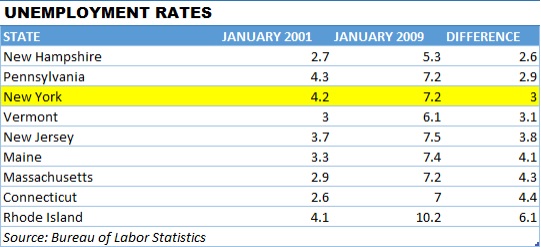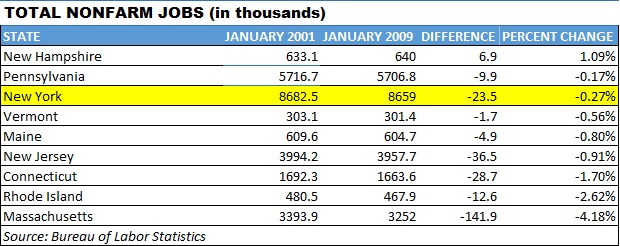Donald Trump distorted the facts when he claimed New York’s job losses during Hillary Clinton’s eight years as the state’s U.S. senator were “worse than just about any place in the country.” During that time, 14 states had steeper job declines than New York, and the state’s unemployment rate was lower than the national average.
The Republican presidential nominee made his remarks during a speech in Pensacola, Florida.
Trump, Sept. 9: Take a look at New York state. When she was a senator from New York state, she campaigned by saying that she was going to bring jobs back to New York state. New York state is a disaster. She got elected, she did nothing. She said see you later in four years. She got elected. Take a look at what happened to New York state. The jobs left. The jobs left. Worse than just about any place in the country. She didn’t do a thing. It was all talk and no action. And that’s what’s going to happen here. She’s all talk. She’s no action. Believe me, she wouldn’t know a job if it stared her in the face.
Trump has criticized Clinton for failing to deliver on a promise to create 200,000 jobs when running for Senate in 2000, citing among other sources an Aug. 7 Washington Post article. He’s right about that.
He’s also right that New York lost jobs, as did many states during the Great Recession. But Trump exaggerates when he says New York’s job losses were “worse than just about any place in the country” when she was senator.
It’s not even one of the worst in the its region — the nine-state Northeast, which the Census Bureau defines to include New York, New Jersey, Pennsylvania, Connecticut, Maine, Massachusetts, New Hampshire, Rhode Island, and Vermont.
Unemployment Rate
Blaming a US. Senator for job losses in their home state makes little sense, particularly during a global recession, which in this case began December 2007 — more than a year before Clinton left the Senate in January 2009 to join the administration of President Barack Obama.
We have long cautioned readers to be wary about jobs claims, which need to be put into the context of regional and national trends. Such claims are usually made by or about governors, and even they have little influence on job creation or loss during a recession.
Nevertheless, Trump made the claim, so let’s look at the facts.
When Clinton took office, in January 2001, the state had 8,682,500 jobs and the unemployment rate was 4.2 percent. When she left, in January 2009, the state had 8,659,000 jobs and the unemployment rate was 7.2 percent. (We are using the standard measure for job growth — total nonfarm jobs, seasonally adjusted — and the official unemployment rate, as measured by the Bureau of Labor Statistics.)
So, the state lost 23,500 jobs – which was a decline of about one-quarter of 1 percent – and the unemployment rate jumped by a full three percentage points. Of course, she left office when the national economy was bleeding jobs at the start of the Great Recession.
How does New York compare to other states? We’ve been told by experts when doing such exercises that it is best to compare neighboring states or those within the same region. So, let’s first look at the unemployment rate of states in the Northeast.
The unemployment rate went up in all nine Northeast states, but New York had the third smallest increase in the unemployment rate. New York’s rate went from 4.2 percent to 7.2 percent, an increase of 3 percentage points, behind only New Hampshire (2.6) and Pennsylvania (2.9).
The worst was Rhode Island, where the unemployment rate increased by 6.1 percentage points, from 4.1 percent to 10.2 percent. We ranked the nine Northeast states by percentage point increase in the unemployment rate in the chart below.

We also looked at the change in New York’s unemployment rate compared to the nation as a whole, and found that the state’s rate grew more slowly than the national average.
The unemployment rates were identical — 4.2 percent — in New York and the U.S. in January 2001. But the nation’s unemployment rate jumped 3.6 percentage points, to 7.8 percent in January 2009, while New York’s rate climbed by 3 percentage points to 7.2 percent.
We also ranked all 50 states by the increase in unemployment rates, with No. 1 having the smallest percentage point increase and No. 50 having the largest. New York ranked 22nd — better than most other states.
Louisiana, which ranked No. 1, saw its unemployment rate during this time increase by just 0.3 percentage points, from 5.8 percent to 6.1 percent. The largest increased occurred in Michigan, where the unemployment rate climb from 4.4 percent to 11.2 percent — a jump of 6.8 percentage points. (Our 50-state data can be found here.)
Job Growth
As for job growth, New York did lose jobs — as did all but one state in the Northeast — from January 2001 to January 2009. New Hampshire was the only Northeast state to gain jobs (7,000) during this time.
New York’s 23,500 job losses represented about a one-quarter of 1 percent loss in jobs during Clinton’s term in office. That was the second smallest rate of decline behind only Pennsylvania. The worst was Massachusetts, which lost 142,000 jobs, or 4.2 percent of its total nonfarm jobs.
We ranked the nine Northeast states by the percent change in total jobs from January 2001 to January 2009 in the chart below.
We also looked at job growth in the nation as a whole during this eight-year period when Clinton was senator, and how New York compared.
There were 18 states that lost jobs, including New York. As we mentioned, New York lost 23,500 jobs, which represented about one-quarter of 1 percent fewer total jobs than it had in January 2001. That ranked New York 36th — which is low, but not “worse than just about any place in the country.”
Wyoming ranked No. 1 with a 21.5 percent increase in jobs; the state saw its number of jobs increase from 242,600 jobs in January 2001 to 294,800 in January 2009. Michigan ranked dead last, losing nearly 662,000 jobs — 14.4 percent of its job base. Other big jobs losers, in order, were Ohio (7.1 percent), Massachusetts (4.1 percent), Illinois (4 percent), Indiana (3.6 percent) and Rhode Island (2.6 percent).
Trump has every right to criticize Clinton for failing to keep her promise to create jobs, but he exaggerates when he claims that New York’s job losses were “worse than just about any place in the country” when she was senator.
https://www.sharethefacts.co/share/607cd8b0-69be-44e4-a226-131b834c7020
